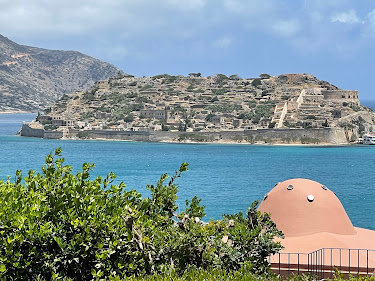We visit Crete and its former leper colony!
Christine and Tony visit Crete and Spinalonga
The latest episode of our podcast provides a Silver Power Review of:
- Domes of Elounda, the 5-star resort where we stayed
- Vicotoria Hislop's fabulous novel about Spinalonga, The Island
- Visiting Crete as vegans
We hope you enjoying it. Meanwhile, below is some background info on Spinalonga.
Spinalonga: A Historical Enclave of Resilience and Isolation
Introduction:
Hidden within the Aegean Sea lies an island with a haunting past, Spinalonga. Located off the coast of Crete, this tiny landmass has witnessed a unique chapter in human history as a leper colony. In this article, we delve into the history of Spinalonga, shedding light on the disease and the reasons for exiling afflicted individuals to the island. Additionally, we explore the impact of Victoria Hislop's book, "The Island," on Greek authorities, citizens, and tourism.
Understanding Leprosy:
Leprosy, also known as Hansen's disease, is a chronic infectious condition caused by the bacterium Mycobacterium leprae. Throughout history, leprosy has been surrounded by misconceptions, leading to stigmatization and social isolation for those afflicted. Contrary to popular belief, leprosy is not highly contagious and can be effectively treated with multidrug therapy today.
The Rise of Spinalonga:
Spinalonga's journey as a leper colony began in 1903 when the Greek government designated the island as a place of confinement for leprosy patients. The decision to exile lepers to Spinalonga was driven by a combination of medical, social, and cultural factors. At the time, there was a lack of understanding about leprosy, and society viewed it as a highly contagious and incurable disease. To protect the general population from the perceived threat, isolating lepers on an uninhabited island seemed like the most practical solution.
Life on Spinalonga:
The lepers' lives on Spinalonga were marked by both hardship and resilience. As a self-contained community, the island provided essential amenities, including houses, hospitals, and even a church. Despite the hardships, the lepers formed a close-knit society, supporting and caring for each other in the face of adversity. Over the years, they developed a unique identity and a shared sense of belonging that helped them cope with the challenges of their condition.
Victoria Hislop's "The Island":
Victoria Hislop's novel, "The Island," published in 2005, brought Spinalonga's history to a broader audience. The book tells a fictional story set against the backdrop of the leper colony, capturing the emotional journey of individuals affected by leprosy. "The Island" resonated with readers worldwide, shedding light on a forgotten chapter of Greek history.
Reception and Impact:
"The Island" received both critical acclaim and widespread recognition. The novel's heartfelt narrative struck a chord with readers, raising awareness about the historical significance of Spinalonga and dispelling misconceptions surrounding leprosy. Greek authorities and citizens embraced the book as an opportunity to revisit their past and confront the stigma associated with leprosy.
Tourism and Spinalonga:
"The Island" also had a profound impact on tourism in the region. Visitors were drawn to Crete, eager to explore the remnants of Spinalonga and gain a deeper understanding of the lepers' lives. The increased interest in the island has led to guided tours, preserving its historical legacy while providing economic benefits to the local community. The influx of tourists has brought attention to the island's cultural heritage, contributing to the preservation and restoration efforts of the leper colony.
Conclusion:
Spinalonga stands as a testament to the strength of the human spirit and the triumph of compassion over fear. The history of this leper colony serves as a reminder of the importance of understanding, empathy, and solidarity in the face of adversity. Victoria Hislop's "The Island" played a pivotal role in raising awareness about Spinalonga and promoting a more inclusive and accepting society. As we continue to learn from the past, Spinalonga's legacy inspires us to embrace compassion and reject stigmatization, ensuring that no one is left isolated or marginalized. By understanding the history of Spinalonga, we honor the resilience of its inhabitants and work towards creating a more inclusive future.
Through the power of storytelling, we uncover forgotten chapters of history and shed light on the experiences of marginalized communities. "The Island" has not only touched the hearts of readers worldwide but also influenced Greek authorities and citizens, fostering a deeper understanding of their own heritage. The novel has sparked a renewed interest in Spinalonga, leading to increased tourism, which in turn supports the preservation and restoration of the leper colony. This cyclical relationship between literature, awareness, and tourism ensures that the memory of Spinalonga endures, and its profound lessons resonate for generations to come.
As we celebrate the progress made in medical advancements and the eradication of the social stigma surrounding leprosy, Spinalonga remains a symbol of strength, unity, and the power of compassion. It reminds us that history's forgotten voices deserve to be heard, and the lessons they teach us should guide our path forward.
So, let us continue to explore the history of Spinalonga, share its stories, and ensure that its legacy lives on as a testament to the resilience of the human spirit and a constant reminder of our collective responsibility to create a more inclusive and compassionate society.




Comments
Post a Comment